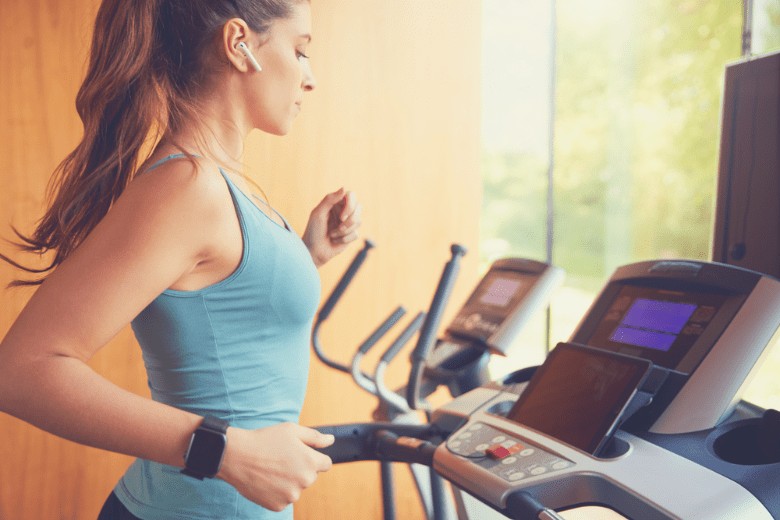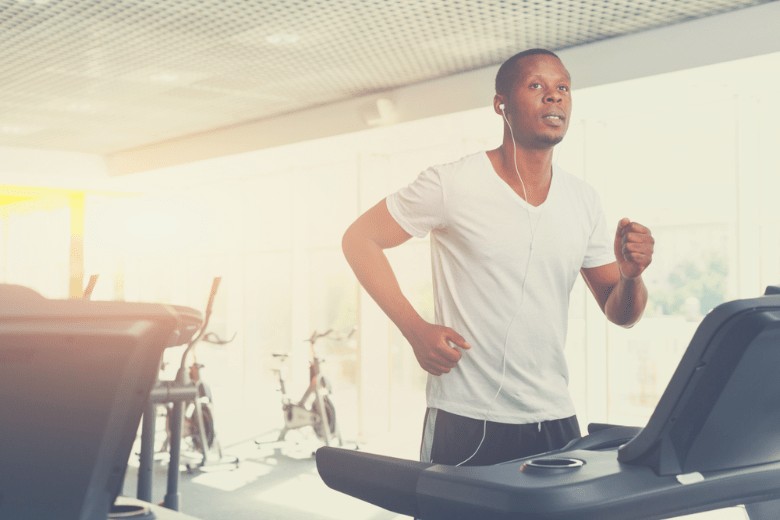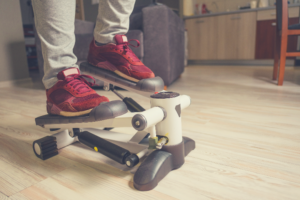Several years ago, my best friend gave me a treadmill.
He is a fitness enthusiast and was concerned about my lack of exercise. I put my gift away and essentially forgot about it.
A few months ago my doctor told me I have Type 2 diabetes. Suddenly I was taking all of these pills and scared.
I started thinking about my treadmill, what I was told about incline running, and decided to change my life.
What is Incline Running?
Setting your treadmill for an incline helps build muscle and increases the number of calories you are burning.
When you run on a treadmill, wind resistance is eliminated. The motor makes movement easier by helping to push and pull your body.
Using an incline of one to three percent offers you the same resistance level as running outside with no incline.
Every hill is graded using a percentage as a basis. This is the reason your treadmill shows your incline as a percentage as opposed to a level.
When you are running using a one percent incline, this is the grade of the hill. The incline for most treadmills can be set from zero to 12 percent.
Mine even has a decline setting. This setting is supposed to ensure you are getting the same workout as if you were outdoors.
The challenge of your run is not dependent on your heart rate, but on the effort required to keep running.
As your endurance builds, you can increase your incline for a better challenge. The higher the incline, the more your leg muscles are worked.
When Should I Increase the Settings for Incline Running?
You need to make certain your form is good before you increase your incline level. You may experience a natural need to lean slightly backward when running or to grip the handrails to help compensate for the incline.
I recommend resisting both of these urges because neither one is beneficial. When you are holding the handrails, you are decreasing the effort required of your leg muscles.
Whether you are sprinting or running, the incline should never be so high you are unable to move properly without holding on or risking the loss of your form.
As your body strengthens, your endurance will improve. Increasing the levels gradually will ensure you are ready for more difficult challenges.
Leaning backward changes both your gait and posture.
This means your glutes are not performing at full power to propel your body uphill.
The best option is using your ankles to bend slightly forward. Place your focus on the balls of your feet landing on the treadmill until you become used to the sensation.
If you are experiencing tightness in your hips, using a higher incline can irritate your muscles.
The majority of experts recommend a moderate incline between two and three percent. You should avoid any incline exceeding seven during your daily workout.
If you are training for a specific event such as an uphill marathon or a steep hike, a higher incline can help you get into better shape.
Using Incline Running for Losing Weight
The reason I started using my treadmill was a combination of better health and weight loss. I found out later I was lucky my treadmill has an incline motor.
This type of motor is different from the belt motor. I even received a warranty specifically for the incline motor.
This motor enables my treadmill to easily switch between low and high inclines.
As I started improving, I began looking at treadmills including a program for randomly switching the incline.
This prevents the body from becoming accustomed to a specific incline. If you are manually changing your incline during a workout, make certain you do so gradually.
I recommend one-half of a percent approximately every two minutes. If you want to lose weight, you need to concentrate on the intensity.
Try to keep your heart rate at 70 to 85 percent of your maximum. This will ensure you burn as many calories as possible.
If your heart rate while running is 90 percent or greater your are risking serious health issues including stroke and heart attack.
Running at a lower incline will not burn the same number of calories, but you will be protecting your health.
Tracking Your Heart Rate
If your treadmill does not have a heart rate monitor, I recommend purchasing one.
It is extremely important to track your heart rate while running to ensure you are not placing too much stress on your heart.
If you want to lose weight, you must be consistent. If you are only capable of running for five minutes, do so. Adults require a minimum of 30 minutes of exercise five days per week.
Try to gradually increase the length of time you are running until you reach the 30-minute mark. If you never reach this mark, some exercise is still a lot better than none.
I have learned running is easier because I have a treadmill in my home.
Less effort is required when you do not need to go to a gym for a good workout. Simply do the best you can, and you should lose weight provided you remain consistent.
Calories Burned
The number of calories you burn is dependent on numerous factors including:
Your Weight
You will burn more calories naturally when you have more weight to lose. This is because there is more excess weight moving throughout your body.
Incline Running
Running on an incline is virtually identical to running up a hill. Your body will need to work harder. The result is burning a larger number of calories than you would without an incline.
The Intensity
You can measure the intensity of your workout by measuring your heart rate. You will burn more calories when the intensity is greater because your heart and lungs must both work harder.
Hand Rails
You will burn a lot fewer calories if you grip the handrails while running.
This is because your treadmill is bearing some of your weight while you are running. You can burn more calories by moving your arms and upper body while working out.
Should I Use Steep Incline Running?
You will learn very quickly that running on your treadmill is different than running outside. When you are outside and running on an incline, you are lifting your feet above the ground every time you take a stride.
Every time one of your feet hits the ground, your joints will feel the force of the impact.
You can easily lessen this impact on your treadmill because you have full control over the level of incline.
Running for a long period of time on a steep incline is not beneficial for your health. If you are training on one of the higher inclines, try not to run for more than three to five minutes.
Lower the incline, then run for 10 to fifteen minutes.
You can then increase the incline again to finish off your run. The idea is to protect your legs, burn a greater number of calories and work your leg muscles.
Too many people have underestimated the importance of the incline settings on their treadmills. An incline is ideal for replicating an outside run.
You can accomplish this with a very small incline setting of one or two.
A lower level will use about the same amount of energy as an outdoor run. You can set steeper inclines as long as you are not running for long periods of time.
You will not be able to run any faster on a treadmill than on an outside track. Do not push yourself to the point of potentially endangering your health.
Decreasing the Risk Of Injury
You can decrease your risk of injury by running on a treadmill as opposed to outside. This is because a greater incline level on a treadmill does not place nearly as much stress on the joints of your body including your hips and knees.
Your level of intensity on a treadmill is lower. If you have any foot issues such as plantar fasciitis, a treadmill is a good option for stretching your calves and Achilles tendon.
If you regularly experience pain in your lower back, you should start with a lower incline to prevent increased pain.
Increase your incline gradually as the muscles in your back begin to strengthen.
Decreasing your incline by just three percent will decrease the impact absorbed by your legs by approximately 24 percent.
Running on your treadmill is less stressful for your joints than going for a run outside.
You can increase your workout intensity while decreasing joint stress by starting with an incline level of one.
Benefits of Incline Running

You can get a great workout on your treadmill without having to leave your house.
You do not have to get up early to drive to the gym, make arrangements to meet a trainer or risk running on unfriendly terrain.
If you want to feel like you have run up and down a hill, just manually adjust your incline by a couple of inches.
This will enable you to receive the most benefits while achieving your fitness goals.
You can control your workout on a treadmill in ways that are impossible on natural terrain. You can structure your workout specifically for your fitness level and individual goals.
You can also run without being exposed to natural elements such as excessive heat or cold and heavy rain.
Improving the Activity of Your Glutes and Hamstrings
Running on a treadmill at an incline significantly increases the activity of your glutes and hamstrings.
This is an excellent way to improve the musculature and strength of your legs.
Exceptional Recovery Method
After completing a high-intensity exercise session, walking on your treadmill using an incline will help your recovery process.
Your blood flow will improve as your body recovers through movement.
Improving Your Speed
The benefits of running on an incline include increased speed. Your legs become stronger, your pain decreases and your breathing improves. The result is a noticeable increase in speed.
Burning Additional Calories
The benefit I was most interested in is burning more calories for enhanced weight loss.
Running uphill or on an incline enhances the intensity of your run. As your heart rate increases, so does the number of calories your body is able to burn.
Promoting Better Muscle Activity
Running on an incline enhances the activity of your ankle, knee and hip muscles. Stronger muscle will improve your endurance level.
Encouragement To Work Even Harder
When you are running on an incline, an effort is required to keep going. This intensifies your workout and triggers your ambition.
In addition to burning more calories and working more muscles, you will be training your mind to help you overcome any obstacles you encounter.
Decreasing The Stress on Your Joints and Extremities
Studies have shown stress placed on the knees is decreased by running at a slight incline.
Gradually increasing your incline between five and 20 percent results in less movement in the internal knee.
An incline enables you to increase the activity of your leg muscles and quadriceps without placing undue stress on your knees.
Your Aerobic Capacity
Running on an incline increases your aerobic capacity.
This is the amount of oxygen your lungs and heart are capable of providing to the muscles throughout your body.
You will also be increasing your stamina, which often leads to a more active and healthier lifestyle.
Dealing with Boredom
If you are bored, you will find an excuse not to work out. If there is no challenge, you will not keep going.
Treadmills have many different inclines to help you change up your routine. When running is inspiring and interesting, you will be able to continue until you reach your goal.
Meeting your goals provides you with the incentive you need to keep running the future.
Improving Your Lung Function
Running on an incline enables you to increase the capacity of your lungs. Your blood flow and respiratory muscles are strengthened by running.
The result is a more efficient and effective use of oxygen. As time passes, your body will be able to handle the extra load. This is what increases your lung function.
Cardiovascular Fitness

Running on an incline is a good way to improve your cardio muscles. Your heart rate slowly increases while you are running.
Gradually increasing your incline helps strengthen your cardiovascular muscles.
Decreasing the Stress on Your Shins
The risk of shin splints is decreased when you run on an incline because you are using your leg muscles effectively with less stress.
Final Thoughts
Are you currently using your incline setting on your treadmill? We’ve highlighted a few of the benefits of running uphill and hope you’ll give it a try on your fitness journey.



